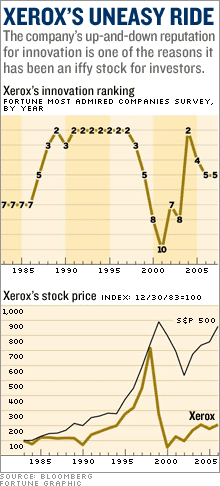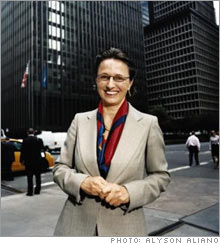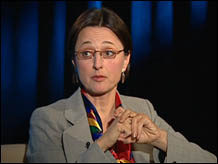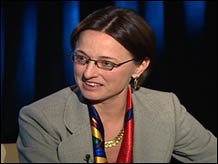Xerox's inventor-in-chiefAn innovation revival has lifted profits to $1.2 billion. Fortune's Geoff Colvin asks CTO Sophie Vandebroek: Can the company keep it up?(Fortune Magazine) -- If all goes as scheduled, President Bush will hand Xerox's Sophie Vandebroek the National Medal of Technology at the White House in late July. It will be a sweet moment for her and for a company that was built on a world-changing innovation - xerography - but that lost its way for a while in the Digital Revolution. The story of how Xerox's Palo Alto Research Center in the 1970s failed to capitalize fully on two of the most critical elements of the personal computer - the graphical user interface and the mouse - has become legend. In 2000, then-CEO Paul Allaire admitted that the company's business model didn't work anymore - a conclusion Wall Street had already reached. A year later Xerox's innovation ranking among its peers plunged to tenth (i.e., last) on Fortune's annual list of America's Most Admired Companies.

Recent years have been better. At a shade less than $16 billion, revenues have not changed much since 2003, but Xerox (Charts, Fortune 500) has increased profits every year, added $7 billion in market cap, and more than tripled its profit margins. One key to the turnaround: Xerox has become an innovation power again, producing new technologies that can read, understand, route, and protect documents, among other things. Leading that effort is Vandebroek, 45, the company's chief technology officer since late 2005. Her task is to keep Xerox at the leading edge of infotech progress in ways that make shareholders richer. Born and raised in Belgium, Vandebroek has a doctorate in electrical engineering from Cornell; she first joined Xerox in 1991. Before an invited audience in New York City, she talked with Fortune's Geoff Colvin about the difference between invention and innovation; why Xerox employs anthropologists; how to make girls passionate about engineering; and much else. Edited excerpts: COLVIN: Innovation may be the hottest topic in business. How can it be a competitive advantage for Xerox? VANDEBROEK: It's a matter of making sure that our customers constantly want to buy our products and services. Ultimately innovation is about delighting the customer, and that results in great economic returns for Xerox. If you innovate and it doesn't end up as something that the customer benefits from, then it's not innovation. How does Xerox make sure that what it comes up with is not just what the engineers think is cool but what customers actually want? It's tough. Innovation has two elements. No. 1, there is the creative piece, the "Aha!" moment. These are our own scientists and researchers and engineers, and our partners. A lot of what we do early on is dreaming and innovating with the customers. These are the early moments of understanding and seeing what nobody else has seen before that could result in a great product or service. The second piece is the "intrapreneurial" role within Xerox, making sure that this creative idea goes through the whole value chain and becomes the right product for the customer. Is there a risk of taking the passion out of something that ought to be full of passion? No. If you can articulate a vision that makes people passionate, there are so many amazing things you can do. We are an almost $17 billion company. Our current market is $120 billion, but the offset [printing] market is $400 billion. So there's enormous opportunity for growth. Some companies renowned for innovation, such as Google (Charts, Fortune 500) and 3M (Charts, Fortune 500), tell employees to spend a certain percentage of time on projects of their own without any guidance. Is that a good idea? Within the broader scope of the vision, we encourage our researchers to spend time on their own - and that vision is articulated with help from the researchers. For example, we have a lot of blogging in the research center, and we created a Wiki to help articulate the strategy that we want to execute. So it's not top down. A lot of the brightest ideas and the best articulations come from within. So what is your vision? It's helping our customers deal with their document-intensive processes. That means making sure they have the information they need when and where they need it, with the history and the context of the information they need. It also means seamlessly bridging the digital and physical, and making it easy and fast to get to information. I want the document to be smart enough so I don't need to worry about it. What is a "smart document"? Here's an example. We recently acquired Amici, an e-discovery firm that works with lawyers. If you have thousands or millions of pieces of evidence, we can use smart-document technology to analyze the contents of the documents, paper or digital - no matter what languages they're in - and get to the facts. So I can ask, "When did Jeff meet Mark and where were they?" If there's a "he" in the document, through machine learning and linguistic analysis we know this "he" is Jeff and not the mayor or Mr. Jones. We also have something called intelligent redaction. You go in the document, and you can redact information, something that is done manually today. You can extrapolate this to the health-care industry, where there are lots of private things about patients you want to redact, or admission processes in universities, or financial institutions. The original information can come in unstructured, like an e-mail or a lab report, or it can come in very structured, like a form, and you can analyze that information, parse it out, and understand what's there. And then the document automatically goes to the right department. What you're describing is research and invention in fields that have nothing to do with how the toner gets put on the paper. In your research centers you have anthropologists, ethnographers, sociologists, psychologists. What's that all about? A big piece of our business is mass customization. How could we personalize Fortune so that every one of your customers gets a personalized copy? People who have conventionally used offset printing have a whole work process in place. So we send in a bunch of sociologists - we call them "work practice specialists" - to observe how people do it. That way, when we come out with our digital presses, it matches the work flow, and the people who will have to start using this completely disruptive technology understand how it works. Otherwise we get all this great invention, and it hits the customers and they don't want to use it. I differentiate between invention and innovation. Innovation is when ultimately this service is rolled out and you actually can use it. What's another example of innovation that came from observing the customer? PARC, our Palo Alto Research Center, has work-practice specialists. They went to observe a typical office customer and noticed that 40% of the paper printed during the day went in the garbage at night, which is very bad. Based on that observation, we invented reusable paper. You print it. You have the notes today. Tonight your paper is blank. You can print on it again tomorrow. The next day it's blank. It's reusable, so it's good for the environment. We're big into being green. It's still an invention. It's not yet an innovation because we now have to figure out how to get an idea like that into the market. What are the most important technologies for Xerox? We do research on six S's. We constantly want to make our systems simpler, speedier, smaller (because smaller means less expensive), smarter (like remote diagnostics, remote prognostics, making sure our customers don't need to deal with their systems because Xerox knows the status of the machine), more secure, and socially responsible (meaning more green technologies). You are president of the Xerox Innovation Group. Does it make sense to have such a thing? The name suggests that innovation happens there rather than everywhere. I agree with you 100% - innovation is only innovation when the creative idea makes a difference to our customers and when they purchase it or work with Xerox to help them with their businesses. Innovation has to cover the whole company, the whole value chain - from research to development to manufacturing, through marketing, sales and service, and consultants. The Innovation Group consists of four research centers: one in Toronto in materials; the Palo Alto Research Center; one in Rochester, N.Y., focused on next-generation systems; and one in Grenoble, France, which does all the intelligent-document research. Within research you play three roles. There's an explorer role, where we push the limits of the technology and constantly look at how we can come up with these bright new ideas, either within the company or working with partners. Then we have the partnership role. You work with the business-group engineers to make sure these cool technologies actually end up in a product or a service. The third role, in the middle, is the incubator. Some of these novel technologies might work in the labs, but before the business groups will take them on you need to make sure no more invention is required. In this phase we try to understand fully the business value of these ideas and incubate them to a level where the business group says, "Yes, I want to invest in that." I gather you're doing something innovative in the way you manage the researchers. We launched a research center on Second Life earlier this year. We bought an island. Our CFO liked it a lot because now the researchers from all the different research centers are meeting in Second Life instead of getting on airplanes. It's really cool because not only can you envision the future today, you can show future concepts and thinking to your customers. We have done our first press release in Second Life and taken some industry analysts and shown them the new products. What is a document in a virtual world? What are the next-generation systems? We do these in Second Life now. When you were getting your doctorate in electrical engineering at Cornell, how many other women were in your class? In my research group, none. When I was getting my master's degree in Belgium, we were 500 students, 15 women. Is the scarcity of women in engineering and related disciplines a problem for innovation? I think it's a major problem. You're excluding half the population from being able to innovate. Girls lose interest in science in middle school. It's not cool. So you have to keep girls and minorities interested in science and technology all through middle school and high school, and especially with girls you have to talk about the social impact an engineer can make. There wouldn't be clean water, there wouldn't be the Internet, there wouldn't be iPods, there wouldn't be airplanes, there wouldn't be the stock market - all these things would disappear if you take away what engineers have done. This is the latest interview by FORTUNE senior editor at large Geoff Colvin with top executives. From the July 9, 2007 issue
|
Sponsors
| ||||||||||||||||||||||||||




